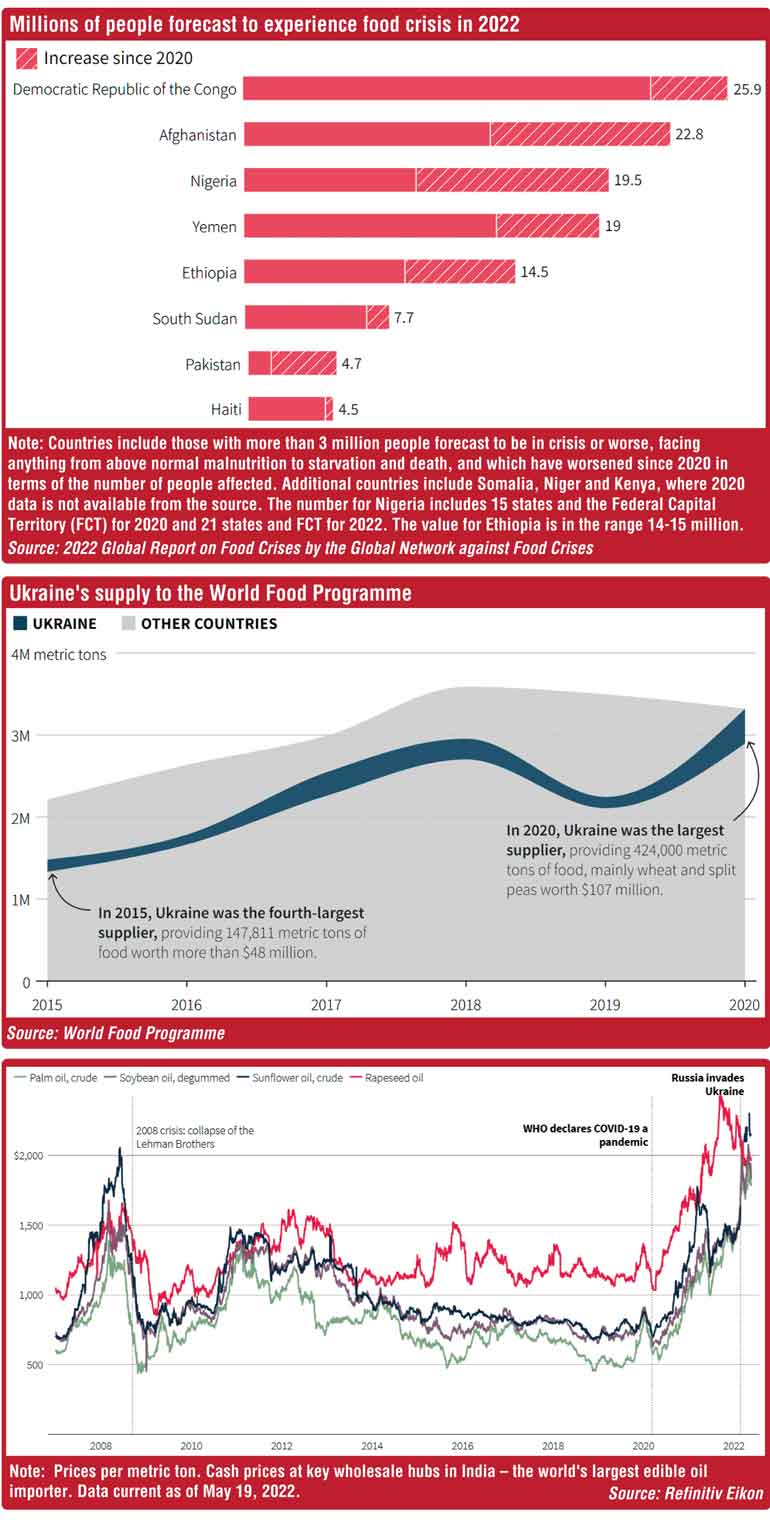Wednesday Dec 10, 2025
Wednesday Dec 10, 2025
Saturday, 4 June 2022 00:00 - - {{hitsCtrl.values.hits}}
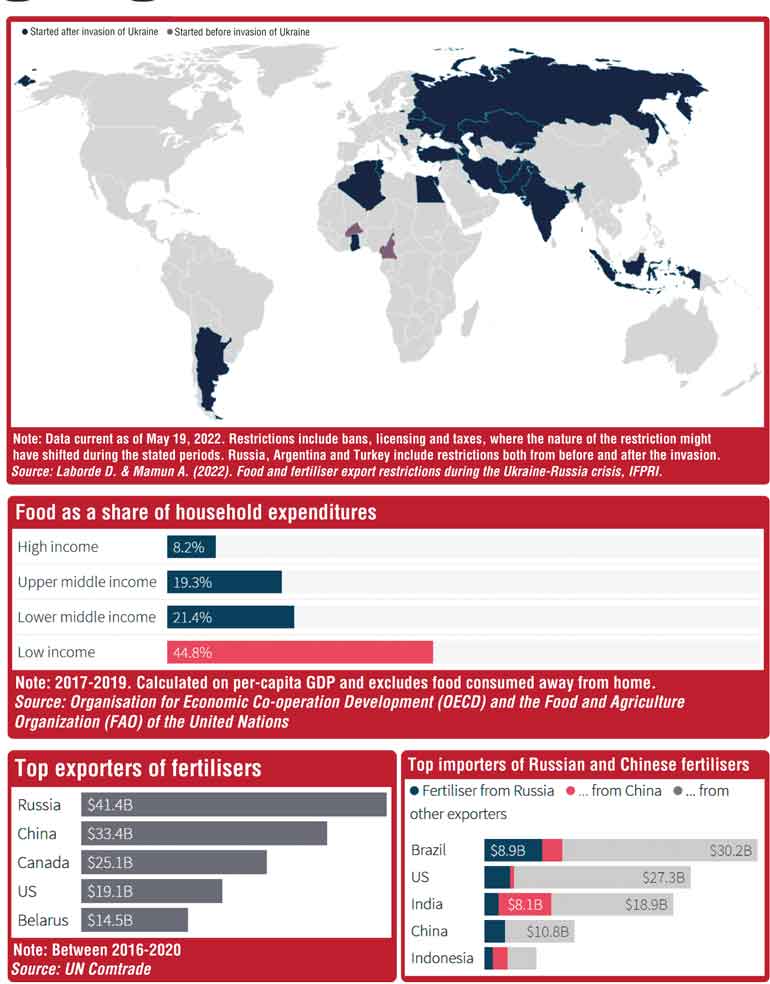
Reuters: Russia’s invasion of Ukraine in late February dramatically worsened the outlook for already inflated global food prices.
The halt in Ukrainian exports following the outbreak of the conflict pushed the Food and Agriculture Organization’s (FAO) food price index, which tracks international prices of the most globally traded food commodities, to its highest point in March since records began in 1990.
Russia’s invasion of Ukraine, a move Russia calls a “special operation” to demilitarise its neighbour, is the latest development in a growing global food crisis.
While post-pandemic global demand, extreme weather, tightening food stocks, high energy prices, supply chain bottlenecks and export restrictions and taxes have been straining the food market for two years, the recent convergence of all these factors following Russia’s invasion is unprecedented and has sent food inflation rates spiking around the world.
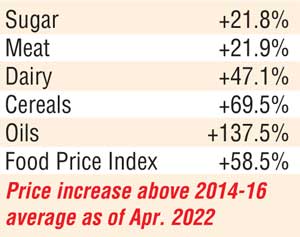 In Europe, the Consumer Price Index for food has sharply risen in all of the continent’s largest economies, while in the United States the CPI climbed more than 14 percentage points since January 2020.
In Europe, the Consumer Price Index for food has sharply risen in all of the continent’s largest economies, while in the United States the CPI climbed more than 14 percentage points since January 2020.
In developing and emerging market countries, the index change is even more dramatic, leaving consumers facing much higher prices for essential food staples.
The most extreme examples have seen food inflation rise hundreds of points. Lebanon, a country that is heavily reliant on food imports including most of its wheat from Ukraine, saw the price index rise more than 3,000 percentage points since 2020.
In many developing nations, food is the single largest category in the overall Consumer Price Index — the selection of goods economists use to calculate people’s overall cost of living. It accounts for about 40% on average, while it rises to half the total cost of living for consumers in India and Pakistan, International Monetary Fund data shows.
Rising prices for basic food items have already fuelled protests in countries around the world, including Argentina, Indonesia and Greece. In Iran, protestors took to the streets after prices for flour-based staples rose as much as 300%.
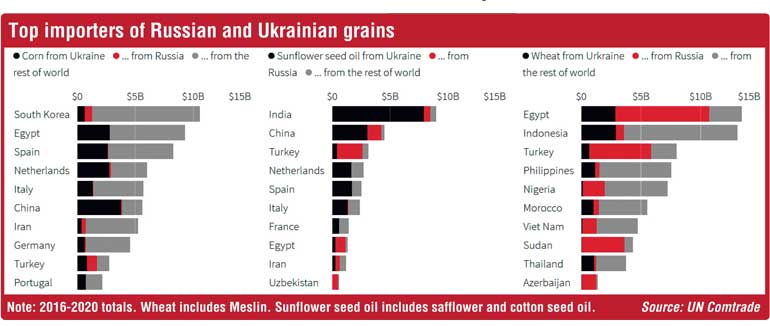
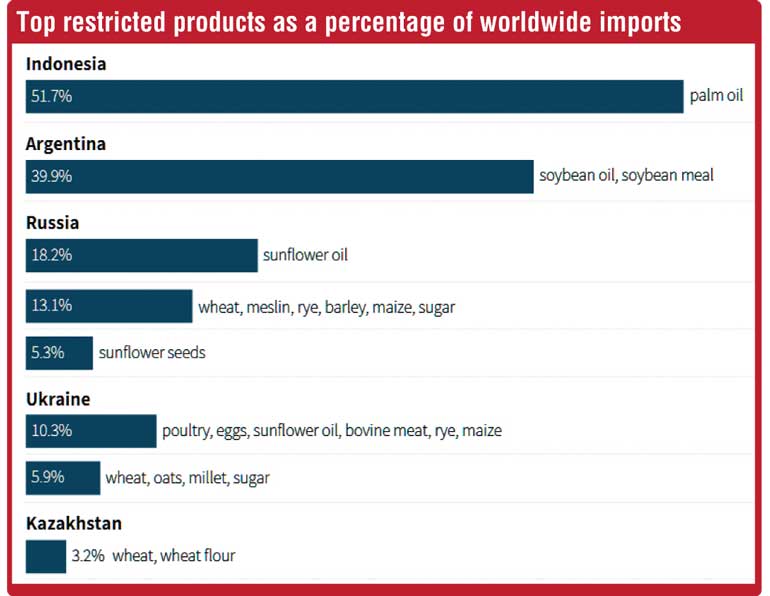
Food supplies under strain
The war has disrupted global agricultural exports from Russia and Ukraine, two grain exporting powerhouses that accounted for 24% of global wheat exports by trade value, 57% of sunflower seed oil exports and 14% of corn from 2016 to 2020, according to data from UN Comtrade.
In the 8 months before the invasion, 51 million metric tons of grain passed through Ukraine’s seven Black Sea ports, according to the United Nations’ World Food Programme (WFP).
Since the invasion, much of Ukraine’s current export grain stock has been stuck in the war-torn country because of damage to rail infrastructure, closed ports and Russian blockades in the Black Sea. Those blockages also mean there won’t be sufficient storage available when the 2022 harvest comes in, according to the WFP.
The shortfall could have devastating consequences for many countries who relied on Ukraine and Russia for as much as half of their wheat imports from 2016 to 2020, including Egypt, who recently made a deal with India to help replace some of the 80% of its wheat imports which come from Russia and Ukraine.
In Europe, the war in Ukraine has mangled major shipping lines through the Baltic and Black Seas, and several key European countries have also banned Russian-flagged vessels from their ports, blocking some Russian grains. The acute effects of the conflict have only added to global transport issues. An early May study by analysts at Royal Bank of Canada (RBC) found that one-fifth of the global container ship fleet was currently stuck in congestion at various major ports.
Global supply chain problems look set to worsen as China’s COVID-19 lockdowns, Russia’s invasion of Ukraine and other strains cause even longer delays at ports and drive up shipping costs.

Blocking exports
With food prices rocketing, a growing list of key producing countries are limiting exports to stabilise prices and protect local markets.
According to data from David Laborde Debucquet and Abdullah Mamun at the International Food Policy Research Institute (IFPRI), restrictions on food and food-related commodities in 2022 could impact as much as 17% of globally traded calories.
Since Russia’s invasion of Ukraine, over 20 countries around the world have imposed restrictions on food exports, including export licences and taxes as well as outright bans.
IFPRI data show that more than two thirds of those restrictions targeted grain exports, such as wheat, rye and barley.
In late April, Indonesia banned most exports of palm oil to protect domestic supplies of cooking oil. The ban shut out the rest of the world from the largest producer of the edible oil, used in everything from cakes to margarine.
India’s May ban on wheat exports delivered a fresh blow to world markets, as a scorching heat wave in the country curtailed output and domestic prices hit a record high.
The impact of recent export bans has also rippled into the energy market.
Cereals and vegetable oils are major components of biofuels, demand for which has ballooned as countries try to find alternatives to fossil fuels. Biofuels had become particularly attractive to the EU as the bloc races to reduce its reliance on Russian oil and gas.
The EU, already in the midst of an energy crisis – and dependent on Russia for 40% of its gas and 27% of oil imports – produces 34% of the world’s biodiesel from vegetable oils, according to data from the Organisation for Economic Co-operation and Development – Food and Agriculture Organization (OECD-FAO).
Crops stalled
Sky-high fertiliser prices have farmers worldwide reducing planned harvests and the amount of land they’re planting.
The fertiliser crisis is in some respects more worrying because it could inhibit food production in the rest of the world that could help take up the slack from stalled Ukrainian and Russian grain deliveries, according to Maximo Torero, chief economist for the U.N. Food and Agriculture Organization.
“If we don’t resolve the problem of fertiliser, and trade of fertilisers doesn’t continue, then we’ll have a very serious problem of [food] supply next year,” Torero told Reuters.
Western sanctions on Russia, a major exporter of potash, ammonia, urea and other soil nutrients, have disrupted shipments of those natural resources around the globe. China last year imposed fertiliser export curbs to protect its own farmers as global prices soared due to strong demand and high energy prices.
Russia and China exported 28% of the world’s fertilisers in terms of trade value from 2016 to 2020 according to a Reuters analysis of UN Comtrade data.
The strain can be seen in agricultural powerhouse Brazil, where some farmers are applying less fertiliser to their corn, and some federal legislators are pushing to open protected indigenous lands for the mining of potash.
In Zimbabwe and Kenya, small farmers are reverting to using manure to nourish their crops.
Those most at risk
Those living in poverty and in countries dependent on food imports are most at risk of suffering from the food inflation crisis.
According to the WFP, 811 million people are chronically hungry. 276 million are living on the brink of starvation and nearly 49 million live in 43 countries on the brink of famine.
Many may reduce meals and the amount of calories they consume, and especially those who are forced to spend a greater portion of their income on food are at risk of being pushed further into poverty to stave off hunger.
Safety nets for those on the brink of hunger, like the WFP, are also at risk of depleted stocks.
In 2020, Ukraine was the top supplier to the United Nations’ World Food Programme – the world’s largest humanitarian organisation that aids some of the most food insecure populations worldwide.
UN Secretary-General Antonio Guterres warned Russia’s war in Ukraine will worsen food, energy and economic crises in poor countries.
“It threatens to tip tens of millions of people over the edge into food insecurity, followed by malnutrition, mass hunger and famine, in a crisis that could last for years.”
The 2022 Global Report on Food Crises estimates that about 180 million people in 41 countries and territories will be in a food crisis this year as a result of conflicts, weather extremes and economic shocks, including the impact of the COVID-19 pandemic.
Those dire forecasts don’t account for the potential impact of the war in Ukraine, but the report warned severe repercussions are also expected at the regional and global level from the conflict.
